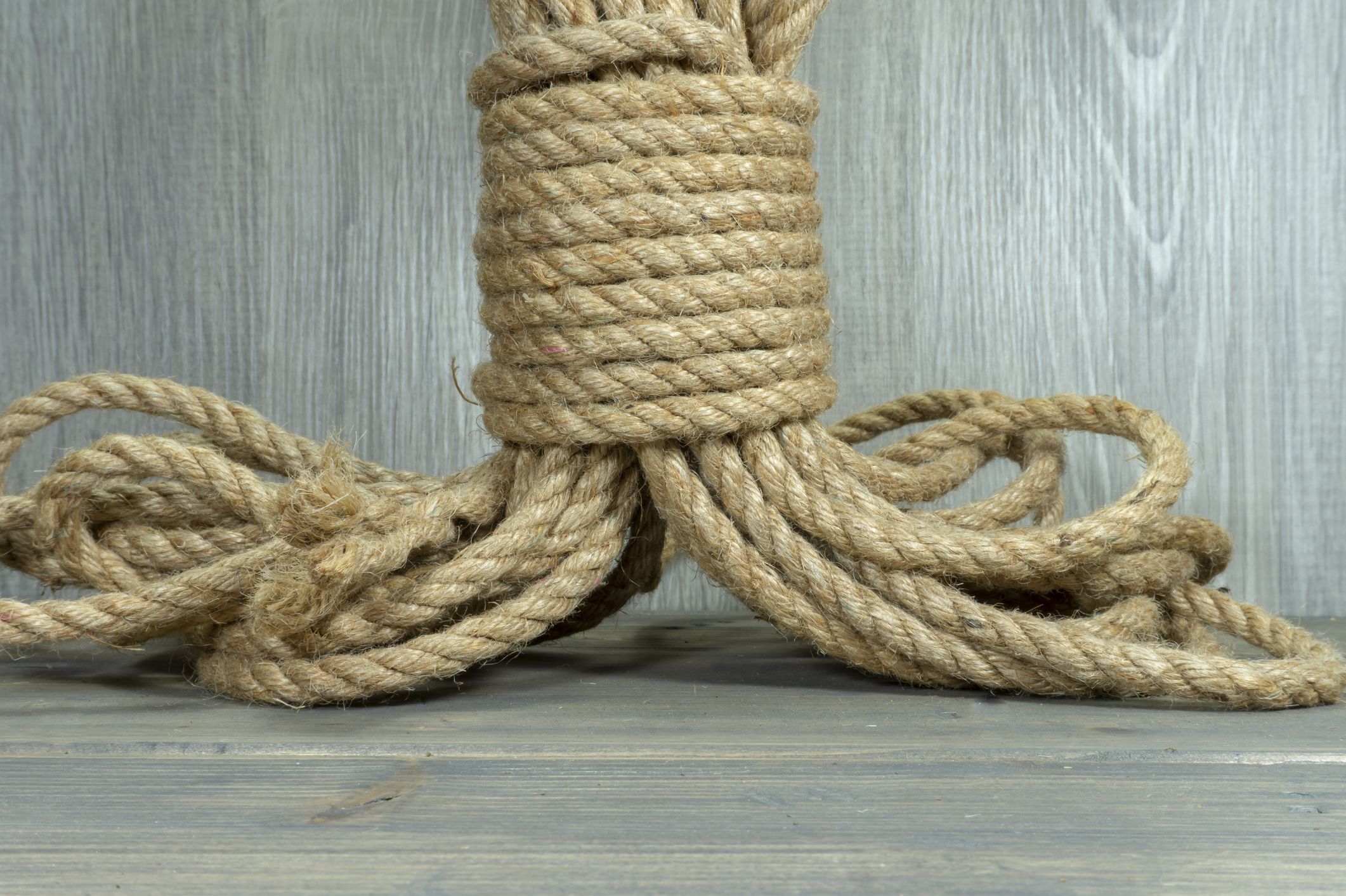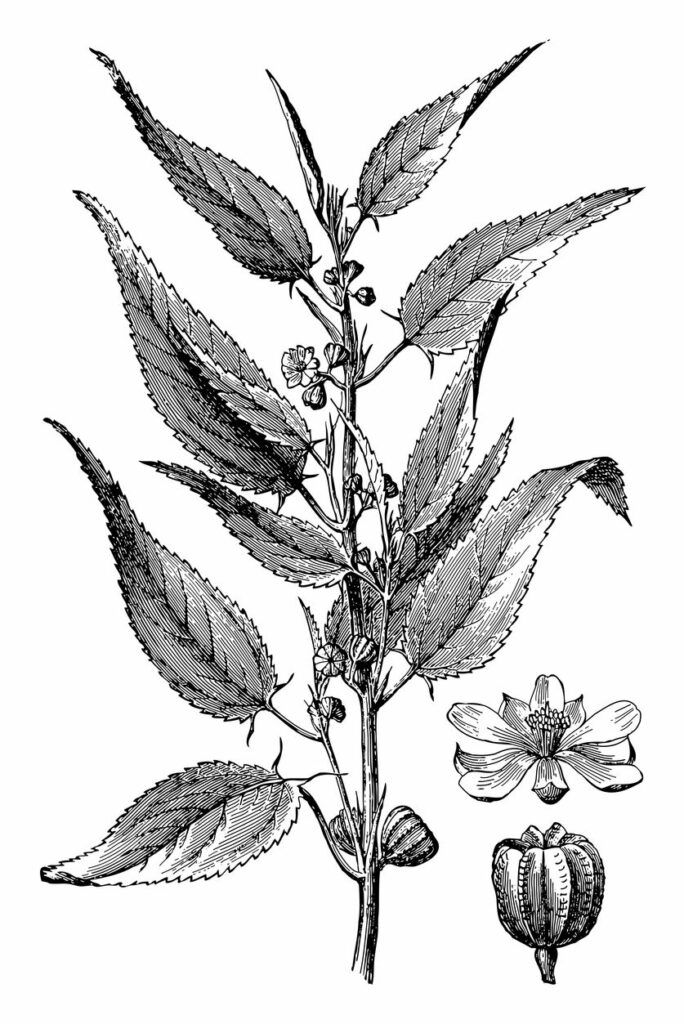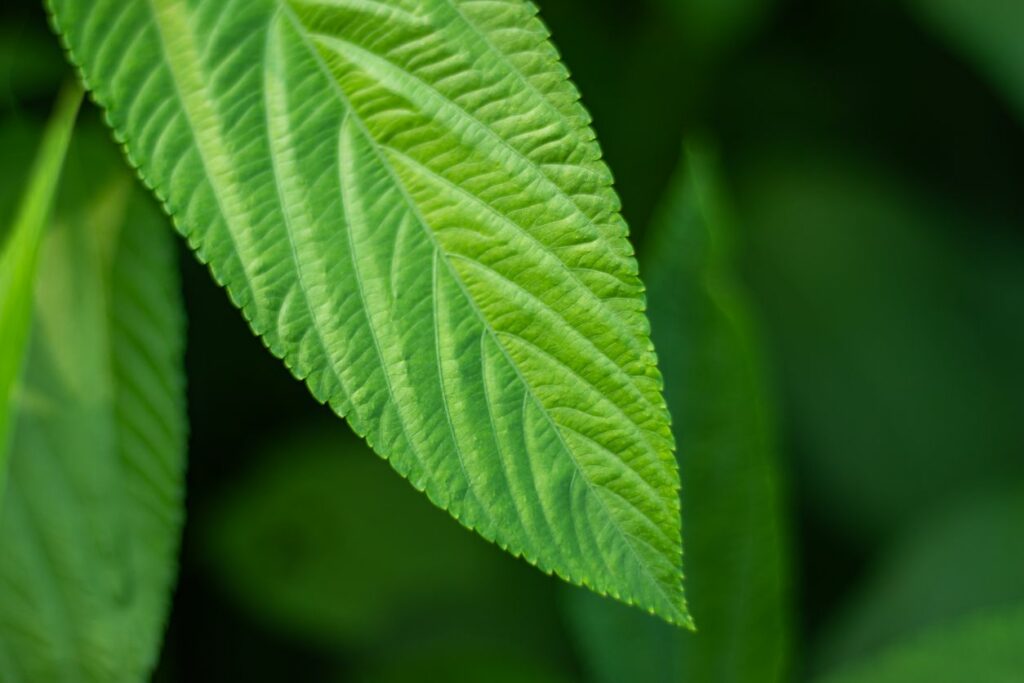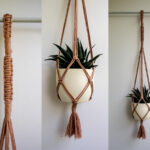Jute rope comprises natural fibers from the jute plant that is native to south Asia. There are two kinds of jute: white and Tossa. White jute is the most common and used for most products. Tossa jute is softer and shinier and is considered superior to white jute.
To make jute rope by hand, the fibers must be “retted.” Bundles of the fibers are soaked in moving water. Then, workers dry and strip the fibers.
Historically, ancient civilizations have been using jute since the 3rd millennium BC. It was most common in Bangledesh for thousands of years. Then, they began trading with the British. The Scots began manufacturing jute, and then the British setup jute plants in India. Still, the western world was no match for the original makers. Southern Asians continue to be the top jute manufacturers in the world.

Jute is a natural, biodegradable fiber, so you can use jute ropes outside. You must treat jute rope to make it last longer, or it will degrade quickly due to the elements. You can seal jute to prevent it from fraying and breaking down.
Jute rope is like other natural fiber ropes but has its own characteristics. Jute is weaker than most natural fiber ropes but holds up better when wet.
Jute rope has seven common uses:
- Sustainable packaging
- Home goods
- Crafts
- Candle Wicks
- Tinder
- Gift Wrapping
- Gardening
What Is Jute Rope?
Jute fiber is soft, but many strands can be woven together to create coarse, strong jute ropes. Jute fibers come from jute plants. The fibers mostly comprise cellulose and lignin. It is a type of “bast” fiber, meaning we collect the fiber from the bast, or the “skin,” of the plant. The raw fiber extracted from the plant is off-white to light brown in color.
The jute plant (genus Corchorus) comes from the mallow family (Malvaceae). Jute plants are tall and skinny and produce flowers.
Jute is the fiber we use to create burlap, gunny cloth, and hessian. We widely produce jute worldwide because it is readily available and affordable. Jute is the second most produced fiber produced worldwide, second only to cotton.
To grow jute, the plant needs alluvial soil. Alluvial soil is high-quality sand, gravel, loose clay, or silt. The soil is transferred to a stream bed or floodplain by running water. The plants also need standing water to grow, so they do their best during the monsoon season. The monsoon season is warm and wet. Temperatures are usually between 68-104°F (40-60°C), and humidity is between 70-80%. To grow properly, jute plants must receive 2-3 in (5-8 cm) of soft water rainfall a week.
There are two types of jute: white jute and Tossa jute. Tossa jute (Corchorus olitorius) is the most abundant plant. White jute (Corchorus capsularis) is not as common but is considered better in quality.
White Jute (Corchorus capsularis)

White jute is a product of its growing location: Bangladesh. The fibers are more golden-white, earning the nickname “Golden Fiber.”
By the 1590s, the Indians were using white jute for clothing. Such use was documented in Ain-e-Akbari by Abu’l Fazl ibn Mubarak. Jute was likely a resource used mainly by the poor villagers. Workers spun jute with simple hand-spinning wheels. The villagers also used hand looms.
Besides clothing, the villagers also used jute rope for household items, like baskets. Baskets that could carry their produce, grains, and other agricultural products were helpful.
Tossa Jute (Corchorus olitorius)

Tossa Jute is also native to South Asia, but the locals consider it much higher quality than white jute. The fibers are stronger, softer, and glossier than white jute fibers. Tossa jute is more brownish in color because of where it’s grown in West Bengal, India.
Coremantel, Bangladesh, is the world’s largest producer of Tossa jute. The crop also grown in West Bengal, India.
How Jute Rope Is Made
The primary producer of jute is South Asia. India and Bangladesh grow more than any other area.
To process jute fibers, they must first be “retted.” Retting refers to gathering a bundle of jute fibers and soaking them in slow-moving water. Workers often stand in the water and shake the bundles to speed up the process. After retting, the bundles dry in the sun, and then stripping begins. The non-fibrous matter is stripped off, then workers pull out the fibers from within the jute stem.
The History Of Jute Rope
The people of the Indus Valley have been using jute to create textiles since the 3rd millennium BC. The ancient Egyptians grew jute for food, and the Jews in the Near East may have also grown it.
Jute isn’t as strong as other natural fibers like hemp and flax, but it is more durable and tear-resistant. These characteristics make jute ideal for making textiles, household goods, and garden work.
Jute Comes To The Western World
Jute has been most important in Bangladesh’s culture for thousands of years. Jute was virtually unheard of in the Western world until the 17th century. The Dutch and French were the first to discover Jute when traveling overseas. They loved it and brought it back to Europe.
In the 17th century, Bangladesh began trading jute with the British. During the British Empire, they began using jute in the military. From there, the British began processing jute and creating manufactured products. Wealthy entrepreneurs called “jute barons” made enormous amounts of money manufacturing jute products.
The First Western Jute Factory
George Drower was the author of “A History of Gardening in 50 Objects.” He says the first jute twine factory in the west was established in Dundee, Scotland, in 1828. Englishman George Acland established that jute factory.
Acland set up his jute factory in Dundee because it was a textile center focused on hemp and flax. Production of jute fibers was a struggle for many years. The fibers are woody and brittle. So, workers could not use the same processing methods they used with hemp or flax.
As the workers learned to process jute, manufacturing officially began in 1832. The business didn’t pick up until 1838. That year, the Dutch government asked for many jute bags to transport coffee from West Africa.
The British Setup Camp In India
Then, the British East India Company and the Dundee Jute Barons set up jute mills in India in 1855. The British mills quickly grew and overtook the Scottish jute trade by 1895. By that time, they had constructed hundreds of mills across Bengel. The success of the Indian jute factories caused the failure of the factories in Scotland. Many Scots began moving to Bengal to set up their jute factories.
Modern Usage Of Jute
During World War 1, over one billion jute bags were transported to the trenches of war-torn Europe. Jute bags were also brought to the southern United States for cotton bagging. The popularity of jute continued to grow. We began using the fibers for construction, firearms, and fishing.
In the 18th and 19th centuries, jute production boomed. Manufacturers discovered how to process jute with machines, ramping up production. Treating the fibers with whale oil allowed machines to spin them. So, workers no longer needed to spin the fibers by hand.
Jute production began to die off in the 1970s with the increased production of plastic. Synthetic fibers are cost-efficient and more effective for mass production.
As time goes by, nations are becoming more environmentally conscious. Nations are outlawing single-use plastics, so jute production is returning. The leading growers and exporters of jute continue to be India and Bangladesh. Together, they produce about 2,700,000 tonnes of jute fiber.
Can Jute Rope Be Used Outdoors?
You can use jute rope outdoors, but it will decompose quickly, and you’ll have to replace it. Jute ropes can absorb up to 34% of their mass in water, but they shrink when wet. Jute rope that gets wet is susceptible to rotting and other water damage.
Try to keep your jute rope dry when using it outdoors. Keep your jute rope under a shelter, if possible, to protect the rope against the elements. Otherwise, bring the rope inside once you’re finished with it.
Many people use jute rope for gardening, so they can’t keep it dry. Jute rope lasts a decent amount of time, but know you’ll have to replace it once it begins to rot.
Add 10-15% to your desired length if you can’t keep your rope dry. The added length accounts for the shrinkage the rope experiences when it gets wet.
Make sure to store your rope correctly when not using it to help it last as long as possible. Avoid having folds in your rope during storage. Folds that sit in your rope for an extended time become stiff and more difficult to work with. Instead, coil the rope lightly, store it inside a bag, or hang it on the wall. Jute rope is resistant to heat and UV light, but it’s still good to take precautions. Store your rope somewhere dry, dark, and cool with low humidity.
How To Condition Jute Rope
Conditioning jute rope is unnecessary, but it will make it softer and easier to work with. Conditioning happens naturally over time as you use your rope. Still, conditioning speeds up the process.
There are six methods for conditioning your rope:
- Breaking or polishing
- Singeing
- Wet treatment
- Baking
- Waxing & oiling
- Sun or freezing
Breaking your rope involves breaking the hardest fibers to make your rope soft. You can place the rope inside a tumble dryer. Another option is to wrap it around a carabiner many times. Then, you’ll move the rope back and forth to break it up. Breaking jute rope makes the rope weaker and creates lots of dust.
Singeing your rope removes the fuzz from your rope and makes it smoother. You’ll need some kind of flame, either from a gas stove or a lighter. Candles work, but leave soot on your rope.
The wet treatment cleans the rope, removes chemicals, and makes the rope more flexible. You can boil the rope or run it through your dishwasher or washing machine.
Baking your rope kills germs and eliminates chemicals in the rope. Baking also makes ropes weaker and more brittle. The chemical vapors are likely toxic, so ensure you do this in a well-ventilated area.
Waxing and oiling keep your rope smooth and healthy. Un-oiled, dry rope becomes more brittle. You should oil your rope regularly to keep it healthy. Be cautious of the ingredients you choose, as some may cause allergies or go rancid after a time. Mineral oil or jojoba oil are usually the best options.
First, prepare the oil. You can place the oil directly on your hands or apply it to a small dishcloth. Second, run your hands or the cloth over the length of the rope.
You can also add wax to your rope along with the oil to give your rope a slicker texture. Only add the wax to the oil after oiling the rope first. Wax often seals rope, so this is a step you want to do after hydrating your rope with oil.
First, mix the wax into the oil to create a thick, soap-like substance. Second, rub the mixture along the length of the rope. Thirdly, bake your rope to allow the oil and wax to sink into the rope’s core. The third step is optional but usually results in a healthier rope.
Exposing your rope to the sun and freezing temperatures kills germs on the rope. Ensure your rope is well-oiled before doing this to prevent the rope from drying out.
How To Keep Jute Rope From Fraying
There are three steps you can take to prevent your jute rope from fraying:
- Rope splicing
- Whipping
- End caps
Rope splicing loops the rope back in on itself and is woven in a way that creates a soft or hard eyelet (splice). The splice is then fitted with a galvanized metal thimble.
Whipping includes wrapping twine around the rope’s end to prevent it from fraying.
End caps are similar to whipping, but they are a more permanent method. End caps are smooth, rigid metal caps that prevent the rope fibers from unraveling. The caps are heat-sealed onto the rope’s end to prevent them from coming off.
Jute VS Other Natural Ropes
Being a natural fiber, jute rope is similar to other natural ropes. Still, they have distinct differences. Consult this chart to compare jute and other natural ropes:
Comparison Of Natural Ropes
| Jute | Manila | Cotton | Hemp | Sisal | |
| Strength | Fair | Good | Weak | Fair | Fair |
| Shock Absorbancy | Poor | Poor | Poor | Poor | Poor |
| Elasticity | Poor | Poor | Poor | Poor | Poor |
| Floats | No | No | No | No | No |
| Water Absorption | 100% | 100% | 100% | 100% | 100% |
| Shrinks When Wet | Yes | Yes | Yes | Yes | Yes |
| Resistant To UV | Good | Good | Good | Good | Good |
| Resistant To Abrasion | Poor | Poor | Poor | Poor | Poor |
| Resistant To Rot | Poor | Poor | Poor | Poor | Poor |
| Resistant To Acids | Poor | Poor | Poor | Poor | Poor |
| Resistant To Alkalis | — | Good | Poor | — | Good |
Uses For Jute
Jute is versatile and affordable. It is the second most important vegetable fiber, just behind cotton. Farmers often use jute to wrap cotton and other agricultural products.
The plant’s versatility allows the production of cheap and finely made goods. Jute butts are the coarse ends of the plants, which we use to create cheap cloth like that used to wrap cotton. Fine jute threads from the same plant are shiny and smooth enough to create imitation silk.
Sustainable Packaging
One of the most common uses of jute is for creating sustainable packaging. Unfortunately, plastic is cheaper, so the production of jute has subsided somewhat. Companies have long since replaced their jute packaging with plastic.
Home Goods
Jute rope’s durability makes it an excellent choice for home decor:
- Rugs
- Baskets
- Lampshades
- Decorations
Jute rope gives homes an earthy, natural feel for a minimalist aesthetic. You can buy jute rope products, but many people DIY their furnishings with jute rope.
Many upcycle wine bottles, flower pots, containers, and more with jute rope. You can easily wrap jute rope around these items and attach it with hot glue.
Jute Rope Crafts
Just as you can decorate your home with jute rope, it’s excellent for creating crafts:
- Wreaths
- Crochet
- Placemats
- Ornaments
- Coasters
- Paper mache
- Bracelets
- Dream catchers
- Macrame
Jute twine and rope are versatile for use in many different crafts. You can weave the threads in crochet, or your can wrap and twist the threads. Jute is a strong natural fiber that can handle a variety of tasks.
How To Dye Jute Rope With Direct Dye Packets
The best way to dye your jute rope is to use direct dye packets. Some of the best dyes include Rit or iDye. Dyes absorb into natural fibers more readily than paints.
Follow these steps to dye your jute rope:
- Unravel your rope and soak it in warm water.
- Tie the end of the rope to a dowel rod.
- Fill a large pot about ⅔ full with boiling water. After it’s boiling, lower the temperature to a simmer.
- Add 1 tbsp of dish soap to the water to help spread the dye.
- Use a glass measuring cup to boil 2 cups of water in the microwave.
- Mix the powdered dye packet into the microwaved water. Use as much or as little of the dye as you like.
- Place the rope in the simmering water, ensuring you submerge all the rope. Place the end of the dowel rod in the pot’s handle out of the water.
- Slowly pour the dye mixture into the pot, stirring with a wooden or plastic spoon.
- After five minutes, add ½ cup of vinegar to the pot to increase the intensity of the color.
- Allow the rope to simmer for 30 minutes. Stir regularly to ensure the even distribution of the dye.
- Dump the water and rope into the sink. First, rinse the rope with warm water, then slowly transition to cold water. Squeeze out excess dye. Continue until the water runs clear.
- Wring out the rope, wrap it around the dowel, and hang it to dry.
How To Dye Jute Rope With Acrylic Paint
Follow these steps to dye your jute rope:
- Wrap the ends of your rope with tape to prevent unraveling.
- Squirt 3 tbsp acrylic paint into a large bowl. Add 2 cups of water. Stir the paint and the water with a soft paintbrush until thoroughly mixed.
- Wearing gloves, dip your jute rope into the bowl of diluted paint. Massage the paint mixture into the rope’s fibers, so it soaks it up.
- Lay your jute rope on a garbage bag covered with a piece of newspaper to dry. Completely untwist the rope and lay it flat. Check the rope after a few hours and flip it over for even drying. Drying may take six or more hours.
The Best Glue For Jute Rope
The kind of glue that works best with your jute rope depends on the project you’re completing. You should use wood glue to attach jute rope to a piece of wood. Hot glue works well for simple crafts, but E6000 is excellent for a solid hold with a more permanent bond.
Candle Wicks
Natural jute twine makes a good candle wick, but you’ll want to treat it for better use. Candlemakers treat their jute with oil, salt, wax, or borax. The twine will last longer within the candle if you braid it first.
Use As Tinder
Like candle wicks, you can use jute as a tinder source to start fires. Having jute during camping or backpacking trips is helpful if you need to start a fire but can’t find enough wood. Jute is lightweight, so it’s easy to carry in a backpack. You can easily separate the strands to create a larger surface area for a larger fire.
Gift Wrapping
Jute twine is a good substitute for ribbon because it’s cheap and biodegradable. Tie a bit of jute around your present to give it a unique touch. To make it look even nicer, combine jute twine with brown gift wrap or glue on pinecones and flowers.
Gardening
Jute rope is natural and biodegradable. These characteristics make it the perfect material for outdoor gardens:
- Binding
- Hanging planters
- Sectioning the garden
Most gardeners use jute as an alternative to metal or plastic binders that damage plants. Jute is a soft fiber that causes minor abrasion on your plants. The twine is also suitable for sectioning your garden to separate crops. You can also construct simple hanging planters from jute.
FAQs
Can I Use Jute Twine For Cooking?
Jute twine isn’t used for cooking, but jute fiber is. Tossa jute is praised for its culinary excellence. Jute leaves are a popular ingredient in a dish called “molokhiya.” Molokhiya is famous across Egypt, Syria, Jordan, and other Arabic countries. The jute plant is a healthy ingredient. It contains high amounts of protein, iron, calcium, vitamin C, and beta-carotene.
Nigerians use Tossa jute leaves to make their “ewedu” soup. Ewedu soup also contains sweet potatoes, shrimp, or fish. The leaves are shredded before being added to the dish.
Is Jute Rope Safe For Dogs?
Many vets do not recommend using rope toys for your dog because they’re easy to pull off and swallow. A swallowed rope fiber is a “linear foreign body” and is one of the most dangerous things a dog can swallow. One end of the rope often remains stuck in the stomach while the other end tries to pass through the intestines. The rope fiber begins to cinch the stomach and intestines, pulling them into a tight ball. Dogs often end up with severe lacerations and permanent damage as a result.
Is Jute Rope Safe For Cats?
As with dogs, you must use caution when using jute rope with your cat. Cats are less likely to swallow rope fibers than dogs. You should still use caution, especially if you have a particularly destructive cat. Usually, jute is used as wrapping around scratching posts. Cats enjoy tearing at the jute rope because of its coarse texture. These toys are generally safe.
Is Jute Rope Safe For Birds?
As with dogs and cats, there is a risk of impaction when using ropes with your birds. Jute is safer than cotton because it is more brittle and breaks down more readily. Still, you should remove rope toys whenever they begin to fray. Removing fraying rope toys prevents your birds from swallowing. It also prevents the threads from wrapping around their feet.




